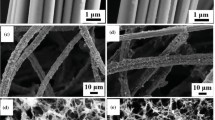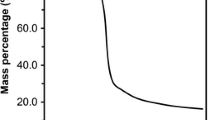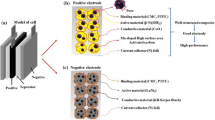Abstract
In this study, polyimide (PI)-based activated carbon fibers (ACFs) were prepared for application as electrode materials in electric double-layer capacitors by varying the steam activation time for the PI fiber prepared under identical cross-linking conditions. The surface morphology and microcrystal structural characteristics of the prepared PI-ACFs were observed by field-emission scanning electron microscopy and X-ray diffractometry, respectively. The textural properties (specific surface area, pore volume, and pore size distribution) of the ACFs were calculated using the Brunauer–Emmett–Teller, Barrett–Joyner–Halenda, and non-local density functional theory equations based on N2/77 K adsorption isotherm curve measurements. From the results, the specific surface area and total pore volume of PI-ACFs were determined to be 760–1550 m2/g and 0.36–1.03 cm3/g, respectively. It was confirmed that the specific surface area and total pore volume tended to continuously increase with the activation time. As for the electrochemical properties of PI-ACFs, the specific capacitance increased from 9.96 to 78.64 F/g owing to the developed specific surface area as the activation time increased.






Similar content being viewed by others
Data availability
Not applicable.
References
Rabaia MKH, Abdelkareem MA, Sayed ET, Elsaid K, Chae KJ, Wilberforce T, Olabi AG et al (2021) Environmental impacts of solar energy systems: a review. Sci Total Environ 754:141989. https://doi.org/10.1016/j.scitotenv.2020.141989
Olabi AG, Abdelkareem MA (2021) Energy storage systems towards 2050. Energy 219:119634. https://doi.org/10.1016/j.energy.2020.119634
Bang JH, Lee HM, An KH, Kim BJ (2017) A study on optimal pore development of modified commercial activated carbons for electrode materials of supercapacitors. Appl Surf Sci 415:61–66. https://doi.org/10.1016/j.apsusc.2017.01.007
Shao Y, El-Kady MF, Wang LJ, Zhang Q, Li Y, Wang H, Mousavi MF, Kaner RB (2015) Graphene-based materials for flexible supercapacitors. Chem Soc Rev 44:3639–3665. https://doi.org/10.1039/c4cs00316k
An X, Xing G, Wang J, Tian Y, Liu Y, Wan Q (2021) Preparation of activated carbon spheres and their electrochemical properties as supercapacitor electrode. Carbon Lett 31:667–676. https://doi.org/10.1007/s42823-021-00241-6
Wei L, Yushin G (2012) Nanostructured activated carbons from natural precursors for electrical double layer capacitors. Nano Energy 1:552–565. https://doi.org/10.1016/j.nanoen.2012.05.002
Miller JR, Burke A (2008) Electrochemical capacitors: challenges and opportunities for real-world applications. Electrochem Soc Interface 17:53–57. https://doi.org/10.1149/2.f08081if
Yang Z, Zhang J, Kintner-Meyer MCW, Lu X, Choi D, Lemmon JP, Liu J (2011) Electrochemical energy storage for green grid. Chem Rev 111:3577–3613. https://doi.org/10.1021/cr100290v
Daffos B, Taberna PL, Gogotsi Y, Simon P (2010) Recent advances in understanding the capacitive storage in microporous carbons. Fuel Cells 10:819–824. https://doi.org/10.1002/fuce.200900192
Shi H (1996) Activated carbons and double layer capacitance. Electrochim Acta 41:1633–1639. https://doi.org/10.1016/0013-4686(95)00416-5
Mayer ST, Pekala RW, Kaschmitter JL (1993) The aerocapacitor: An electrochemical double-layer energy-storage device. J Electrochem Soc 140:446–451. https://doi.org/10.1149/1.2221066
Li J, Wang X, Wang Y, Huang Q, Dai G, Sebastian PJ (2008) Structure and electrochemical properties of carbon aerogels synthesized at ambient temperatures as supercapacitors. J Non-Cryst Solids 354:19–24. https://doi.org/10.1016/j.jnoncrysol.2007.07.024
Thillaikkarasi D, Karthikeyan S, Ramesh R, Sengodan P, Kavitha D, Muthubalasubramanian M (2022) Electrochemical performance of various activated carbon-multi-walled carbon nanotubes symmetric supercapacitor electrodes in aqueous electrolytes. Carbon Lett 32:1481–1505. https://doi.org/10.1007/s42823-022-00386-y
Mathew EE, Balachandran M (2021) Crumpled and porous graphene for supercapacitor applications: a short review. Carbon Lett. https://doi.org/10.1007/s42823-021-00229-2
Qi K, Hou R, Zaman S, Xia BY, Duan H (2018) A core/shell structured tubular graphene nanoflake-coated polypyrrole hybrid for all-solid-state flexible supercapacitors. J Mater Chem 6:3913–3918. https://doi.org/10.1039/c7ta11245a
Shrestha LK, Wei Z, Subramaniam G, Shrestha RG, Singh R, Sathish M, Ma R, Hill JP, Nakamura J, Ariga K (2023) Nanomaterials 13:946. https://doi.org/10.3390/nano13050946
Wang Q, Luo Y, Hou R, Zaman S, Qi K, Liu H, Park HS, Xia BY (2019) Redox tuning in crystalline and electronic structure of bimetal–organic frameworks derived cobalt/nickel boride/sulfide for boosted faradaic capacitance. Adv Mater 31:1905744. https://doi.org/10.1002/adma.201905744
Qi K, Hou R, Zaman S, Qiu Y, Xia BY, Duan H (2018) Construction of metal–organic framework/conductive polymer hybrid for all-solid-state fabric supercapacitor. ACS Appl Mater Interfaces 10:18021–18028. https://doi.org/10.1021/acsami.8b05802
Kim JH, Jung SC, Lee HM, Kim BJ (2022) Comparison of pore structures of cellulose-based activated carbon fibers and their applications for electrode materials. Int J Mol Sci 23:3680. https://doi.org/10.3390/ijms23073680
Li M, Xiao H, Zhang T, Li Q, Zhao Y (2019) Activated carbon fiber derived from sisal with large specific surface area for high-performance supercapacitors. ACS Sustain Chem Eng 7:4716–4723. https://doi.org/10.1021/acssuschemeng.8b04607
Chiang YC, Chen YJ, Wu CY (2017) Effect of relative humidity on adsorption breakthrough of CO2 on activated carbon fibers. Materials 10:1296. https://doi.org/10.3390/ma10111296
Wang C, Bai L, Zhao F, Bai L (2022) Activated carbon fibers derived from natural cattail fibers for supercapacitors. Carbon Lett 32:907–915. https://doi.org/10.1007/s42823-022-00329-7
Zhu K, Wang Y, Tang JA, Guo S, Gao Z, Wei Y, Chen G, Gao Y (2017) A high-performance supercapacitor based on activated carbon fibers with an optimized pore structure and oxygen-containing functional groups. Mater Chem Front 1:958–966. https://doi.org/10.1039/c6qm00196c
Liu C, Wang H, Zhao X, Liu H, Sun Y, Tao L, Huang M, Shi J, Shi Z (2020) Cellulose-derived carbon-based electrodes with high capacitance for advanced asymmetric supercapacitors. J Power Sources 457:228056. https://doi.org/10.1016/j.jpowsour.2020.228056
Lee HM, Kim HG, Kang SJ, Park SJ, An KH, Kim BJ (2015) Effects of pore structures on electrochemical behaviors of polyacrylonitrile (PAN)-based activated carbon nanofibers. J Ind Eng Chem 21:736–740. https://doi.org/10.1016/j.jiec.2014.04.004
Lee HM, Kwac LK, An KH, Park SJ, Kim BJ (2016) Electrochemical behavior of pitch-based activated carbon fibers for electrochemical capacitors. Energy Convers Manag 125:347–352. https://doi.org/10.1016/j.enconman.2016.06.006
Zhang J, Zhang W, Zhang H, Pang J, Cao G, Han M, Yang Y (2017) Novel casting TiAl alloy with fine microstructure and excellent performance assisted by ultrasonic melt treatment. Mater Lett 206:67–70. https://doi.org/10.1016/j.matlet.2017.06.091
Hina K, Zou H, Qian W, Zuo D, Yi C (2017) Preparation and performance comparison of cellulose-based activated carbon fibres. Cellulose 25:607–617. https://doi.org/10.1007/s10570-017-1560-y
Aoh AL, HA, Yahya R, Jamil Maah M, Radzi Bin Abas M, (2013) Adsorption of methylene blue on activated carbon fiber prepared from coconut husk: isotherm, kinetics and thermodynamics studies. Desal Water Treat 52:6720–6732. https://doi.org/10.1080/19443994.2013.831794
Kawahara Y, Otoyama S, Yamamoto K (2015) Direct carbonization of high-performance aromatic polymers and the production of activated carbon fibers. J Text Eng. https://doi.org/10.4172/2165-8064.1000219
Vázquez-Santos MB, Castro-Muñiz A, Martínez-Alonso A, Tascón JMD (2008) Porous texture evolution in activated carbon fibers prepared from poly (p-phenylene benzobisoxazole) by carbon dioxide activation. Microporous Mesoporous Mater 116:622–626. https://doi.org/10.1016/j.micromeso.2008.05.033
Kaburagi Y, Yokoi K, Yoshida A, Hishiyama Y (2005) Highly graphitized carbon fiber prepared from poly (p-phenylene-benzo-bis-oxazole) fiber. TANSO. https://doi.org/10.7209/tanso.2005.111
Shah SAA, Idrees R, Saeed S (2022) A critical review on polyimide derived carbon materials for high-performance supercapacitor electrodes. J Energy Storage 55:105667. https://doi.org/10.1016/j.est.2022.105667
Ali-Shah SA, Idrees R, Saeed S (2022) A critical review on polyimide derived carbon materials for high-performance supercapacitor electrodes. J Energy Storage 55:105667. https://doi.org/10.1016/j.est.2022.105667
Inagaki M, Harada S, Sato T, Nakajima T, Horino Y, Morita K (1989) Carbonization of polyimide film “Kapton. Carbon 27:253–257. https://doi.org/10.1016/0008-6223(89)90131-0
Wang XF, Xiong L, Zhong JJ, Jin L, Yan JL, Mu B, Song ZYG, SL, (2020) Nitrogen-containing porous carbon fibers prepared from polyimide fibers for CO2 capture. Ind Eng Chem Res 59:18106–18114. https://doi.org/10.1021/acs.iecr.0c03318
Bhat GS, Schwanke R (1997) Thermal properties of a polyimide fiber. J Therm Anal 49:399–405. https://doi.org/10.1007/bf01987463
Kaneda T, Katsura T, Nakagawa K, Makino H, Horio M (1986) High-strength–high-modulus polyimide fibers II. Spinning and properties of fiber. J Appl Polym Sci 32:3151–3176. https://doi.org/10.1002/app.1986.070320122
Pope CG (1997) X-Ray diffraction and the Bragg equation. J Chem Educ 74:129. https://doi.org/10.1021/ed074p129
Biscoe J, Warren BE (1942) An X-ray study of carbon black. J Appl Phys 13:364–371. https://doi.org/10.1063/1.1714879
Brunauer S, Emmett PH, Emmett E (1938) Adsorption of gases in multimolecular layers. J Am Chem Soc 60:309–319. https://doi.org/10.1021/ja01269a023
Lippens B (1965) Studies on pore systems in catalysts: V. The t method. J Catal 4:319–323. https://doi.org/10.1016/0021-9517(65)90307-6
Barrett EP, Joyner LG, Halenda PP (1951) The determination of pore volume and area distributions in porous substances. I. Computations from nitrogen isotherms. J Am Chem Soc 73:373–380. https://doi.org/10.1021/ja01145a126
Kierlik E, Rosinberg M (1990) Free-energy density functional for the inhomogeneous hard-sphere fluid: application to interfacial adsorption. Phys Rev A 42:3382–3387. https://doi.org/10.1103/physreva.42.3382
Wei B, Wei T, Xie C, Li K, Hang F (2021) Promising activated carbon derived from sugarcane tip as electrode material for high-performance supercapacitors. RSC Adv 11:28138–28147. https://doi.org/10.1039/d1ra04143f
Lee HM, Lee BH, Kim JH, An KH, Park SJ, Kim BJ (2019) Determination of the optimum porosity for 2-CEES adsorption by activated carbon fiber from various precursors. Carbon Lett 29:649–654. https://doi.org/10.1007/s42823-019-00080-6
Baek J, Lee HM, Roh JS, Lee HS, Kang HS, Kim BJ (2016) Studies on preparation and applications of polymeric precursor-based activated hard carbons: I. Activation mechanism and microstructure analyses. Microporous Mesoporous Mater 219:258–264. https://doi.org/10.1016/j.micromeso.2015.07.003
Baek J, Shin HS, Chung DC, Kim BJ (2017) Studies on the correlation between nanostructure and pore development of polymeric precursor-based activated hard carbons: II. Transmission electron microscopy and Raman spectroscopy studies. J Ind Eng Chem 54:324–331. https://doi.org/10.1016/j.jiec.2017.06.007
Sharma A, Kyotani T, Tomita A (1999) A new quantitative approach for microstructural analysis of coal char using HRTEM images. Fuel 78:1203–1212. https://doi.org/10.1016/s0016-2361(99)00046-0
Sing KSW (1985) Reporting physisorption data for gas/solid systems with special reference to the determination of surface area and porosity (Recommendations 1984). Pure Appl Chem 57:603–619. https://doi.org/10.1351/pac198557040603
Thommes M, Kaneko K, Neimark AV, Olivier JP, Rodriguez Reinoso F, Rouquerol J, Sing KSW (2015) Physisorption of gases, with special reference to the evaluation of surface area and pore size distribution (IUPAC Technical Report). Pure Appl Chem 87:1051–1069. https://doi.org/10.1515/pac-2014-1117
Oginni O, Singh K, Oporto G, Dawson Andoh B, McDonald L, Sabolsky E (2019) Effect of one-step and two-step H3PO4 activation on activated carbon characteristics. Bioresour Technol Rep 8:100307. https://doi.org/10.1016/j.biteb.2019.100307
Kim DW, Kil HS, Nakabayashi K, Yoon SH, Miyawaki J (2017) Structural elucidation of physical and chemical activation mechanisms based on the microdomain structure model. Carbon 114:98–105. https://doi.org/10.1016/j.carbon.2016.11.082
Shiratori N, Lee K, Miyawaki J, Hong SH, Mochida I, An B, Yokogawa K, Jang J, Yoon SH (2009) Pore structure analysis of activated carbon fiber by microdomain-based model. Langmuir 25:7631–7637. https://doi.org/10.1021/la9000347
Lastoskie C, Gubbins KE, Quirke N (1993) Pore size heterogeneity and the carbon slit pore: a density functional theory model. Langmuir 9:2693–2702. https://doi.org/10.1021/la00034a032
Xue C, Hao W, Cheng W, Ma JH, Li RF (2019) Effects of pore size distribution of activated carbon (AC) on CuCl dispersion and CO adsorption for CuCl/AC adsorbent. J Chem Eng 375:122049. https://doi.org/10.1016/j.cej.2019.122049
Ahn JR, Lee HM, Kim BJ (2023) Highly mesoporous activated carbon fibers using high density polyethylene precursor with a multi-step stabilization technique for automobile carbon canister. J Ind Eng Chem 128:578–585. https://doi.org/10.1016/j.jiec.2023.08.024
Barbieri O, Hahn M, Herzog A, Kötz R (2005) Capacitance limits of high surface area activated carbons for double layer capacitors. Carbon 43:1303–1310. https://doi.org/10.1016/j.carbon.2005.01.001
Baek J, An KH, Chung DC, Kim BJ (2017) Correlation studies between pore structure and electrochemical performance of activated polymer-based hard carbon with various organic and aqueous electrolytes. Int J Energy Res 42:2927–2939. https://doi.org/10.1002/er.3939
Lin R, Taberna PL, Chmiola J, Guay D, Gogotsi Y, Simon P (2009) Microelectrode study of pore size, ion size, and solvent effects on the charge/discharge behavior of microporous carbons for electrical double-layer capacitors. J Electrochem Soc 156:A7. https://doi.org/10.1149/1.3002376
González A, Goikolea E, Barrena JA, Mysyk R (2016) Review on supercapacitors: technologies and materials. Renew Sustain Energy Rev 58:1189–1206. https://doi.org/10.1016/j.rser.2015.12.249
Zhang SS, Xu K, Jow TR (2006) Charge and discharge characteristics of a commercial LiCoO2-based 18650 Li-ion battery. J Power Sources 160:1403–1409. https://doi.org/10.1016/j.jpowsour.2006.03.037
Minakshi M, Wickramaarachchi K (2023) Electrochemical aspects of supercapacitors in perspective: From electrochemical configurations to electrode materials processing. Prog Solid State Ch 69:100390. https://doi.org/10.1016/j.progsolidstchem.2023.100390
Hung K, Masarapu C, Ko T, Wei B (2009) Wide-temperature range operation supercapacitors from nanostructured activated carbon fabric. J Power Sources 193:944–949. https://doi.org/10.1016/j.jpowsour.2009.01.083
Kim JH, Lee HM, Jung SC, Chung DC, Kim BJ (2021) Bamboo-based mesoporous activated carbon for high-power-density electric double-layer capacitors. Nanomaterials 11:2750. https://doi.org/10.3390/nano11102750
Funding
This research was supported by the Carbon Industry Foundation project no. 20016795 (development of manufacturing technology independence of advanced activated carbons and application for high-performance supercapacitor) and project no. 20016774 (development of activated carbon fiber and module for vaporization solvent recovery) funded by the Ministry of Trade, Industry, and Energy of the Republic of Korea. This research was also supported by the Nano-Material Technology Development Program through the National Research Foundation of Korea (NRF-2019M3A7B9071501) funded by the Ministry of Science and ICT of the Republic of Korea.
Author information
Authors and Affiliations
Contributions
Conceptualization, B-JK; Data curation, D-JK,H-ML and B-JK; Formal analysis, D-JK; Funding acquisition, K-HA and B-JK; Investigation, D-JK and H-ML; Methodology, B-JK; Project administration, H-ML; Resources, K-HA and B-JK; Software, D-JK, H-ML; Supervision, H-ML, K-HA and B-JK; Validation, D-JK, H-ML, K-HA and B-JK; Visualization, D-JK; Writing—original draft, D-JK; Writing—review and editing, D-JK, H-ML, K-HA and B-JK All authors have read and agreed to the published version of the manuscript.
Corresponding authors
Ethics declarations
Conflict of interest
The authors declare no conflict of interest.
Additional information
Publisher's Note
Springer Nature remains neutral with regard to jurisdictional claims in published maps and institutional affiliations.
Supplementary Information
Below is the link to the electronic supplementary material.
Rights and permissions
Springer Nature or its licensor (e.g. a society or other partner) holds exclusive rights to this article under a publishing agreement with the author(s) or other rightsholder(s); author self-archiving of the accepted manuscript version of this article is solely governed by the terms of such publishing agreement and applicable law.
About this article
Cite this article
Kang, DJ., Lee, HM., An, KH. et al. Preparation of polyimide-based activated carbon fibers and their application as the electrode materials of electric double-layer capacitors. Carbon Lett. (2024). https://doi.org/10.1007/s42823-024-00705-5
Received:
Revised:
Accepted:
Published:
DOI: https://doi.org/10.1007/s42823-024-00705-5




